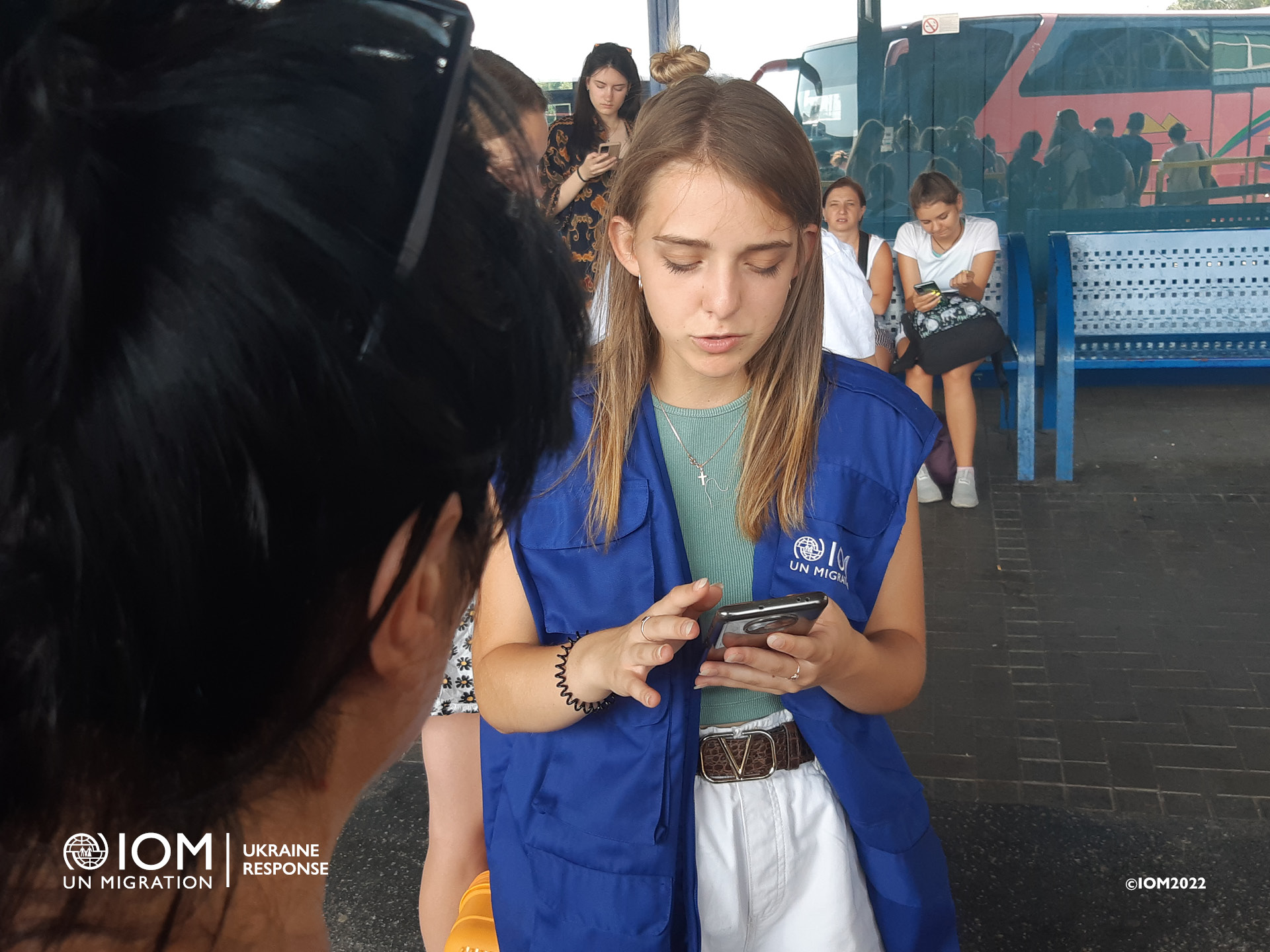Tento článok je publikovaný len v anglickom jazyku.
Forty-nine per cent of those interviewed who crossed the border back to Ukraine declared an intent to remain in Ukraine, according to the International Organization for Migration (IOM) data released as of 17 August 2022.
The data comes from a report based on face-to-face interviews with 185 Ukrainian refugees and third-country nationals (TCNs) crossing back to Ukraine from Slovakia. The surveys were conducted between 19 April and 31 July 2022.

An IOM consultant at the Kosice bus station makes survey with people crossing back to Ukraine from Slovakia about their mobility, needs and intentions. Photo © International Organization for Migration (IOM) 2022.
Profile of interviewees
The people surveyed indicated Kyiv (29%), Kharkiv (15%), Dnipropetrovsk, Donetsk and Zakarpatska (all three account for 8%) as the top five regions of habitual residence (before leaving Ukraine), and three-quarters of the respondents plan to return to the region where they had resided.
Zakarpatska (44%), Kyiv and Lvivska (both 12%) oblasts were mentioned as top destinations for those who do not plan to go back to their previous habitual residence. The main reasons for this include: damaged or destroyed house (23%); their family moved to another location (21%); and the location of origin is currently unsafe (19%).
Women accounted for 94 per cent of respondents. Their average age was 39, compared to 59 for men. The largest age cohort (37%) was represented by female respondents aged 30-39 years.
Top findings
Most immediate needs
Fifty-four per cent of the respondents reported they were in need of transportation support, followed by food, financial support and access to water.
With whom they are traveling back
Almost half of the respondents (49%) were traveling to Ukraine with the same group/household with whom they had fled. The large majority of these (91%) were crossing back with immediate family members; others with friends and neighbours or relatives.
More than two-thirds (69%) of the respondents left Ukraine in March and April 2022.
Where they stayed after leaving Ukraine
Around three-quarters (73%) of the respondents stayed for most of their time in Slovakia, with the majority hosted in Kosice (36%), Presov (19%) and Zilina (12%).
The next two top countries of destination were Germany (10%) and Hungary (6%).
Main intentions
Forty-nine per cent of those surveyed intend to remain in Ukraine, while 28 per cent are only returning for a short visit. The remainder did not know how long they would stay (19%) or preferred not to answer the question (4%).
Reasons for going back to Ukraine
Of those respondents planning to stay in Ukraine, 51 per cent stated that they were traveling back to Ukraine because they perceived that the situation in their place of origin/habitual residence had improved. Other reasons included reunion with family members (21%), the fact that they did not have enough resources to cover the cost of living (21%) or difficulty in getting a job (13%) in Slovakia. Respondents also indicated other challenges they faced while abroad including: finding shelter/accommodation, access to education and/or obtaining humanitarian assistance.
The main reasons given by respondents for crossing back to Ukraine for a short visit were to meet family members, to collect some personal belongings left in Ukraine and to provide help to other family members or friends in Ukraine.
About the IOM surveys
The first round of 185 surveys with people crossing back to Ukraine from Slovakia were conducted by IOM’s Displacement Tracking Matrix (DTM) team in Slovakia between 19 April and 31 July 2022 at two Border Crossing Points at Vyšné Nemecké, Ubľa, the Michalovce and Humenné Registration Centres, and Červená Hviezda Hotspot in Košice.
Read the report
Find all IOM Slovakia reports here:
https://displacement.iom.int/slovakia
Displacement Tracking Matrix (DTM)
The DTM is a system to track and monitor displacement and population mobility. It is designed to regularly and systematically capture, process and disseminate data and information to provide a better understanding of the movements and evolving needs of displaced populations, whether on site or en route, both in country and at the global level.
With the support of:
The IOM’s DTM activities in the region were made possible with financial support from the Council of Europe Development Bank, France, German Federal Foreign Office, Government of Japan, Norwegian Ministry of Foreign Affairs, Swiss Agency for Development and Cooperation, and United States Bureau of Population, Refugees, and Migration.




![]()


This activity was generously funded by the U.S. Department of State Bureau of Population, Refugees, and Migration.
 Slovenčina
Slovenčina
 Українська (Україна)
Українська (Україна)
 English
English
